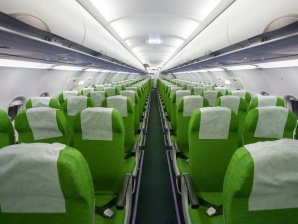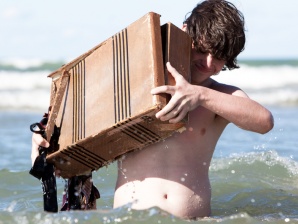Coming Soon to the US Navy's Aircraft Carriers: The F-35C Stealth Fighter
A hook lowers from the back end of the F-35C aircraft, designed to catch the cable and slow down the plane. In order to maintain its stealth configuration, the aircraft’s hook is internal to the airframe, Navy developers said.
On all the legacy systems, the tail hook sits up underneath the engine externally. Upon landing, three doors open up and allow the tail hook to fall down, Navy pilots said.
The aircraft also needs to be able to withstand what’s called a “free flight,” a situation where the pilot receives a late wave off to keep flying after the hook on the airplane has already connected with the wire, pilots added.
Testing the F-35C on a Carrier
Developmental Testing III, or DT-III, is the third of three at-sea test phases planned for the F-35C. Naval aircraft are slated to go through DT-I, -II and -III test phases in order to ensure the development of aircraft meets specifications and properly identifies mission critical issues sufficiently early in the test phase.
Two F-35C Lightning II carrier variants conducted their first arrested landings aboard USS Dwight D. Eisenhower (CVN 69) off the coast of the eastern United States on Oct. 2, 2015.
U.S. Navy test pilots Cmdr. Tony "Brick" Wilson and LT Chris "TJ" Karapostoles landed F-35C test aircraft CF-03 and CF-05, respectively, aboard USS Eisenhower's flight deck, according to a 2014 report from Military.com (also from Kris Osborn). The arrested landing was part of the F-35's two week at-sea Developmental Testing (DT-II) phase.
During DT-I in 2014, the F-35 Lightning II made aviation history when it conducted its inaugural arrested landings and catapult launches aboard an aircraft carrier. The first-ever carrier-based flight operations of the F-35C occurred Nov. 3 aboard USS Nimitz (CVN 68).
F-35C test pilots and engineers from the F-35 Lightning II Pax River Integrated Test Force based at Naval Air Station Patuxent River in Patuxent River, Maryland, tested the suitability and integration of the aircraft with carrier air and deck operations in an at-sea environment Nov. 3-14, 2014.
The F-35C demonstrated exceptional performance both in the air and on the flight deck, accelerating the team's progress through the DT-I schedule, achieving 100 percent of the threshold test points three days early and conducting night ops during DT-I - an unheard of feat since the Navy's F-4 era.
By 2025, the Navy's aircraft carrier-based air wings will consist of a mix of F-35C, F/A-18E/F Super Hornets, EA-18G Growlers electronic attack aircraft, E-2D Hawkeye battle management and control aircraft, MH-60R/S helicopters and Carrier Onboard Delivery logistics aircraft such as the emerging Navy Osprey tiltrotor aircraft variant.
Lockheed Martin is the aircraft contractor and Pratt & Whitney is the engine contractor. Several reports, including on from “War is Boring,” cite the F-35C cost per plane as more than $337 million.
(Some of the information cited in this report also appeared in a 2014 report from Kris Osborn in military.com)
Kris Osborn became the Managing Editor of Scout Warrior in August of 2015. His role with Scout.com includes managing content on the Scout Warrior site and generating independently sourced original material. Scout Warrior is aimed at providing engaging, substantial military-specific content covering a range of key areas such as weapons, emerging or next-generation technologies and issues of relevance to the military. Just prior to coming to Scout Warrior, Osborn served as an Associate Editor at the Military.com. This story originally appeared in Scout Warrior.





No comments:
Post a Comment